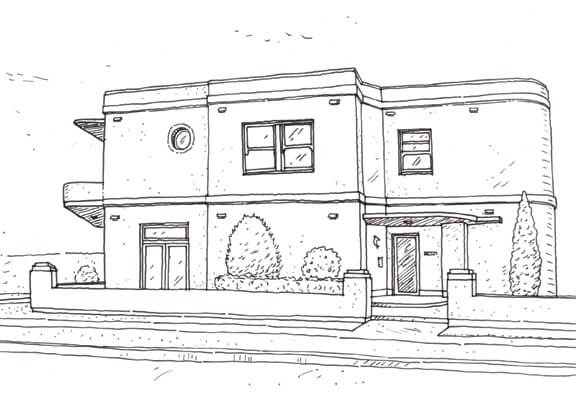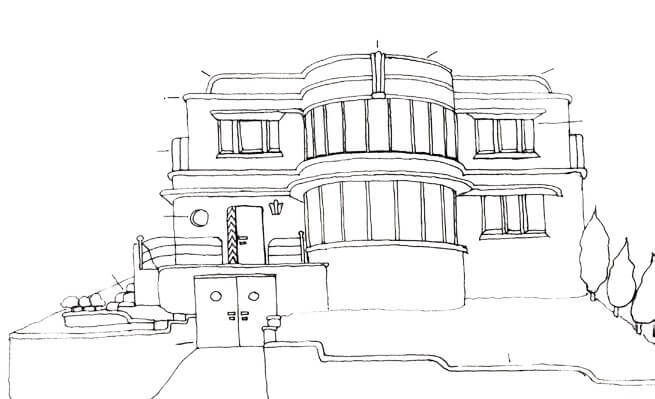P&O AND ART DECO THE NORTHERN BEACHES
Excellent examples of P&O/Art Deco can be found in the Manly area, dating from the 1920s and 30s. The styles, and related Functionalist style, date from a period of international modern themes in architecture and marked an attempt to break with the past and build bold new forms to usher in the modern age.
Manly’s built heritage contributes to creating a strong sense of place and is an important link to the past. The eclectic styles and details found here were influenced by international trends in architecture, lifestyle and finished with local details. Manly Council encourages residents to take an active interest in conserving their rich built heritage.
In Sydney, Art Deco built forms can be seen in houses of patterned brickwork and vertical turrets fronting plain brick buildings with parapets, corner windows and curved corners.
Art Deco was especially influential in flat building in Manly. P&O houses were particularly popular in the Seaforth/Clontarf area where many properties sit on prominent harbour sites. Although flat roofs are most commonly associated with this period, traditional roofs hidden by parapets are also found around Manly.

P&O and Art Deco Windows and Doors
P&O houses: circular porthole windows and semi—circular cut-out projections over doors and windows. Art Deco houses: often have vertical feature windows to decorate a covered external stairwell.
Both styles: metal window frames; doors and entrance ways are generally plain although decorative motifs above doorways are common.
Complementing or repeating existing window proportions and groupings are some important considerations in proposed alterations or additions.
P&O and Art Deco Outside
Streetscape and Parking – Important Considerations:
The impact of renovations and additions on the streetscape and on adjacent heritage items, particularly when second storeys or façade changes are proposed. Second storeys should be in proportion to existing building and should have some details that relate to the architectural style of the house to draw them together. Consistency with adjacent houses in features like bulk, roofline, building line and fencing.
Art Deco and P&O houses are characterised by a uniform external appearance with long sweeping lines and uniform external cladding and trim. Parking at the rear, side or on the street is preferred if possible. Garages are common in P&O/Art Deco but should be designed to minimise impact on the house’s character and quality of the streetscape. P&O and Art Deco Character Features:
- Wide decks and balconies with nautical details (P&O)
- Rows of cypresses
- Rendered low walls that match material of house walls.

P&O and Art Deco Wall and Roof Finishes
Both styles rely on strong geometric forms and horizontal lines. Vertical and horizontal bands ending in parapet fins and roofs concealed behind a decorative parapet are typical. Art Deco houses: patterned brickwork with terracotta roof tiles and feature parapets. P&O houses: generally white or light coloured rendered walls with horizontal bands, nautical details and motifs and roofs concealed behind a uniform parapet.
Using appropriate colour for the house and trim, retaining horizontal details and roof line are some basic wall and roof finish considerations for sympathetic alterations to P&O/Art Deco houses.
P&O and Art Deco Background
Art Deco is named for the Exposition des Arts Decorative held in Paris in 1925 where prominent architects met to share their desire to create a truly modern style of architecture. They sought to reject historical styles and to introduce new forms. They were inspired by the clean lines of modern forms like ocean liners and stylised machines.
New building technology and machinery contributed to these emerging styles, allowing characteristic finishes such as curved glass windows, steel frames and curving flush walls.
P&O and Art Deco Examples on the Northern Beaches:
- 34-38 Posonby Parade, Seaforth
- 12-18 Palmerston Place, Seaforth
- 13 Ponsonby Parade, Seaforth
- Steyne Hotel, The Corso, Manly
- Manly Ferry Wharf, West Esplanade, Manly
Note: Private buildings are not open for inspection and can be viewed from the street only
